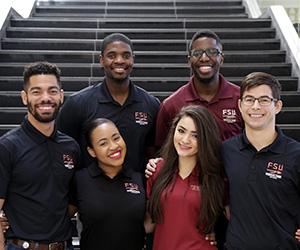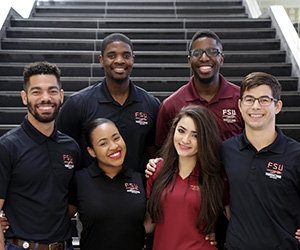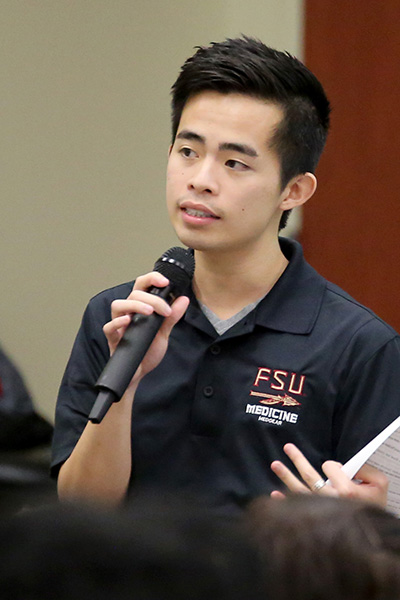Students’ events focus on social responsibility


Jan. 25, 2017
With back-to-back weeks of compelling discussions on medicine and social justice, 2017 has gotten off to a strong start at the College of Medicine.
Cover the Uninsured Week is a traditional event. Racism Awareness Week is brand-new. Together this month, they’ve sent a message that students care about their patients, their communities and the wider world in which they’ll practice medicine. And they’re not afraid to tackle tough topics.
The organizers of Racism Awareness Week were Nadia Akhiyat, Zedeena Fisher, Bryno Gay (who created the RAW logo), Michael Morgan, Acton Pifer and Eric Walker. They began by founding a chapter of the national group WhiteCoats4BlackLives. Fisher said the inspiration came during a roundtable discussion late last year in one of their living rooms.
“We saw a need for a better understanding, a safe dialogue and action,” Fisher said. “And thankfully, the administration stood behind us wholeheartedly. There is truly unity in knowledge, and I hope that this series is evidence of that.”
The keynote presentation featured John Hoberman, author of “Black and Blue: The Origins and Consequences of Medical Racism.” He outlined the barriers that health-care faculty, students and staff may face and the importance of supporting the advancement of minority groups in medical academic institutions.
He defined medical racism in three contexts:
- “Racially differential diagnosis and treatment that causes medical harm.”
- “Organized medicine’s refusal to take action in response to the hundreds of peer-reviewed articles that have demonstrated … that black patients get inferior care in many medical specialties.”
- “Mistreatment of black medical personnel.”
“The compulsion to find racial difference is so thorough in our culture,” said Hoberman, who teaches at the University of Texas at Austin, “that of course it seeps into the medical culture.” He said the country has long been “marinating in contemptuous folklore about black human beings. It is a big, big, big problem.”
.jpg) Other RAW presentations featured College of Medicine faculty members. Assistant Professor Michael Nair-Collins discussed “Racism and White Privilege: Two Sides of the Same Coin.” Associate Professor Joseph Gabriel participated in a panel exploring the historical development of race. Professor George Rust led a discussion of “Advocacy: What Can We Do?”
Other RAW presentations featured College of Medicine faculty members. Assistant Professor Michael Nair-Collins discussed “Racism and White Privilege: Two Sides of the Same Coin.” Associate Professor Joseph Gabriel participated in a panel exploring the historical development of race. Professor George Rust led a discussion of “Advocacy: What Can We Do?”
Cover the Uninsured Week, taking place this week, also has enlisted a mix of faculty members, community members – including some who are uninsured – and visiting experts. Among the faculty participants were Rust and Jeffrey Harman.
The keynote speaker, scheduled for Thursday, is Chicago physician Susan Rogers, M.D., a board member of Physicians for a National Health Program. She’ll explain how a national health program could reduce U.S. health disparities in a sustainable and cost-effective way.
 Student Alan Chan (seen left), director of the CTUW events, wrote an op-ed for the Tallahassee Democrat to promote the activities. In it he wrote: “Compared with those who are privately insured, uninsured patients are five times as likely to postpone or forgo needed medical care because of high out-of-pocket costs.”
Student Alan Chan (seen left), director of the CTUW events, wrote an op-ed for the Tallahassee Democrat to promote the activities. In it he wrote: “Compared with those who are privately insured, uninsured patients are five times as likely to postpone or forgo needed medical care because of high out-of-pocket costs.”
Other key organizers of CTUW Week are students Charlie Ingram, Jasmine Jordan and Olenka Caffo, along with faculty advisor Karen Myers.
Both last week and this week, student organizers have won praise for their hard work and passion. “Most of us think about medical school being one of those things you’ve just got to get through,” Dean John P. Fogarty said. “Well, not only do our students get through, but they are so socially conscious of what’s going on in the lives around them that they want to do something special for each and every one of the people in this community. So I compliment them for that.”
RAW organizer Akhiyat put it this way to her fellow students: “We’re incredibly fortunate to be part of an institution that supports this and that is explicitly committed to diversity. But all of this happened because students no different from any of you saw the need for conversation and for dialogue and made it happen.”

